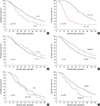Abstract
Purpose
Bone is the most common site of breast cancer metastasis. The aim of this study is to identify the subgroup of patients who have high risk of bone metastasis and we evaluate the prognostic factors of overall survival after bone relapse.
Methods
A total 2,785 of primary breast cancer patients who were treated from January 1980 to December 2001 were included in this analysis. All the patients received radical surgery at the time of diagnosis. We retrospectively collected the clinico-pathologic data (age, tumor size, axillary lymph node status, histologic grade, steroid hormone receptor status, and disease-free interval after primary surgery). Definitive radiologic evidence of bone metastases by plain X-ray or whole body bone scan during follow-up was defined as bone metastases. We analyzed the relationship between the clinicopatholgic factors and the risk of bone metastases and the overall survival after bone relapse.
Results
During follow-up, 256 patients (9.3%) experienced bone metastasis. By multivariate analysis using Cox's model, age less than 35 years (p<0.001, risk ratio [RR]; 2.467, 95% confidence interval [CI]; 1.619-3.759), large primary tumor more than 2 cm (p=0.005, RR; 1.911, 95% CI; 1.222-2.988), positive axillary node (p<0.001, RR; 2.798, 95% CI; 1.867-4.195), and a high histologic grade (p=0.046, RR; 1.631, 95% CI; 1.008-2.640) were significantly associated with frequent bone metastases. The 10 years survival rate after bone metastasis was 26.9%. Disease free interval less than 2 years (p<0.001, RR; 3.453, 95% CI; 2.382-5.005) and hormone receptor status (p=0.003, RR; 1.791, 95% CI; 1.218-2.635) were independently associated with poor overall survival after bone relapse.
Conclusion
We concluded that a shorter disease-free interval after definitive surgery and hormonal receptor status of the primary tumor are independent prognostic factors of overall survival after bone metastasis. These results show that a tailored strategy is needed for the treatment of patients with bone metastases.
Figures and Tables
 | Fig 1Ten years overall survival estimation after bone metastasis according to clinic-pathologic factors. The Kaplan-Meier method was used for overall survival measurement (A, age; B, disease-free interval; C, T stage; D, N stage; E, histologic grade; F, hormone receptor). Age, disease-free interval and hormone receptor status were statistically significant. |
Table 2
Kaplan-Meier bone metastasis free survival estimation according to clinico-pathologic factors

References
3. Galasko CS. Weiss L, Gilbert AH, editors. The anatomy and pathways of skeletal metastases. Bone metastasis. 1981. Boston: Hall Medical Publishers;49–63.
4. Fossati R, Confalonieri C, Torri V, Gnislandi E, Penna A, Pistotti V, et al. Cytotoxic and hormonal treatment for metastatic breast cancer: asystematic review of published randomized trials involving 31,510 women. J Clin Oncol. 1998. 16:3439–3460.

5. Chia SK, Speers CH, D'yachkova Y, Kang A, Malfair-Taylor S, Bar-nett J, et al. The impact of new chemotherapeutic and hormone agents on survival in a population-based cohort of women with metastatic breast cancer. Cancer. 2007. 110:973–979.

6. Coleman RE, Smith P, Rubens RD. Clinical course and prognostic factors following bone recurrence from breast cancer. Br J Cancer. 1998. 77:336–340.

7. Sherry MM, Greco A, Johnson DH, Hainsworth JD. Breast cancer with skeletal metastases at initial diagnosis: distinctive clinical characteristics and favorable prognosis. Cancer. 1986. 58:178–182.

8. Sherry MM, Greco A, Johnson DH, Hainsworth JD. Metastatic breast cancer confined to the skeletal system: an indolent disease. Am J Med. 1986. 81:381–386.
9. Yamashita K, Ueda T, Komatsubara Y, Koyama H, Inaji H, Yonenobu K, et al. Breast cancer with bone-only metastases-visceral metastases-free rate in relation to anatomic distribution of bone metastasis. Cancer. 1991. 68:634–637.

10. Oka H, Kondoh T, Seichi A, Hozumi T, Nakamura K. Incidence and prognostic factors of Japanese breast cancer patients with bone metastasis. J Orthop Sci. 2006. 11:13–19.

11. James JJ, Evans AJ, Pinder SE, Gutteridge E, Cheung KL, Chan S, et al. Bone metastases from breast carcinoma: histopathological-radiological correlations and prognostic features. Br J Cancer. 2003. 89:660–665.

12. Colleoni M, O'Neill A, Goldhirsch A, Gelber RD, Bonetti M, Thürlimann B, et al. Identifying breast cancer patients at high risk for bone metastases. J Clin Oncol. 2000. 18:3925–3935.

14. Donegan WL. Prognostic factors. Stage and receptor status in breast cancer. Cancer. 1992. 70:1755–1764.

15. Falkson G, Gelman RS, Protorius FJ. Age as a prognostic factor in recurrent breast cancer. J Clin Oncol. 1986. 4:663–671.

16. Gonzalez-Angulo AM, Broglio K, Kau SW, Eralp Y, Erlichman J, Valero V, et al. Women age<or=35 years with primary breast carcinoma: disease features at presentation. Cancer. 2005. 103:2466–2472.
17. Rosen PP, Lesser ML, Kinne DW, Beattie EJ. Breast carcinoma in women 35 years of age or younger. Ann Surg. 1984. 199:133–142.

18. Koyama T, Hasebe T, Tsuda H, Hirohashi S, Sasaki S, Fukutomi T, et al. Histological factors associated with initial bone metastasis of invasive ductal carcinoma of the breast. Jpn J Cancer Res. 1999. 90:294–300.

19. Hasebe T, Tsuda H, Hirohashi S, Shimosato Y, Tsubono Y, Yamamoto H, et al. Fibrotic focus in infiltrating ductal carcinoma of the breast: a significant histopathological prognostic parameter for predicting the long-term survival of the patients. Breast Cancer Res Treat. 1998. 49:195–208.

20. Clark GM, Sledge GW, Osborne CK, McGuire WL. Survival from first recurrence: relative importance of prognostic factors in 1,015 breast cancer patients. J Clin Oncol. 1987. 5:55–61.

21. Kamby C, Andersen J, Ejlertsen B, Birkler NE, Rytter L, Zedeler K, et al. Histological grade and steroid receptor content of primary breast cancer: Impact on prognosis and possible modes of action. Br J Cancer. 1988. 58:480–486.

22. Blanco G, Holli K, Heikkinen M, Kallioniemi OP, Taskinen P. Prognostic factors in recurrent breast cancer: relationships to site of recurrence, disease-free interval, female sex steroid receptors, ploidy and histological malignancy grading. Br J Cancer. 1990. 62:142–146.

23. Williams MR, Todd JH, Ellis IO, Dowle CS, Haybittle JL, Elston CW, et al. Oestrogen receptors in primary and advanced breast cancer: an eight year review of 704 cases. Br J Cancer. 1987. 55:67–73.

24. Kominsky SL, Davidson NE. A "Bone" fide predictor of metastasis? Predicting breast cancer metastasis to bone. J Clin Oncol. 2006. 24:2227–2229.

25. Solomayer EF, Diel IJ, Meyberg GC, Gollan C, Baster G. Metastatic breast cancer: clinical course, prognosis and therapy related to the first site of metastasis. Breast Cancer Res Treat. 2000. 59:271–278.

26. Yavas O, Hayran M, Ozisik Y. Factors affecting survival in breast cancer patients following bone metastasis. Tumori. 2007. 93:580–586.

27. Vogel CL, Azevedo S, Hilsenbeck S, East DR, Ayub J. Survival after first recurrence of breast cancer. The Miami experience. Cancer. 1992. 70:129–135.

28. Hietanen P, Miettinen M, Makinen J. Survival after first recurrence in breast cancer. Eur J Cancer Clin Oncol. 1986. 22:913–919.

29. Howat JM, Harris M, Swindell R, Barnes DM. The effect of oestrogen and progesterone receptors on recurrence and survival in patients with carcinoma of the breast. Br J Cancer. 1985. 51:263–270.

30. Howell A, Barnes DM, Harland RN, Redford J, Bramwell VH, Wilkinson MJ, et al. Steroid-hormone receptors and survival after first relapse in breast cancer. Lancet. 1984. 17:588–591.

31. Koenders PG, Beex LV, Kloppenborg PW, Smals AG, Benraad TJ. Human breast cancer: survival from first metastasis. Breast Cancer Study Group. Breast Cancer Res Treat. 1992. 21:173–180.
32. Coleman RE. Metastatic bone disease: clinical features, pathophysiology and treatment strategies. Cancer Treat Rev. 2001. 27:165–176.

33. Cicek M, Oursler MJ. Breast cancer bone metastasis and current small therapeutics. Cancer Metastasis Rev. 2006. 25:635–644.

34. Hurst M, Noble S. Clodronate: a review of its use in breast cancer. Drugs and Aging. 1999. 5:143–167.
35. Hiraga T, Williams PJ, Mundy GR, Yoneda T. The bisphosphonate ibandronate promotes apoptosis in MDAMB-231 human breast cancer cells in bone metastases. Cancer Res. 2001. 61:4418–4424.




 PDF
PDF ePub
ePub Citation
Citation Print
Print





 XML Download
XML Download